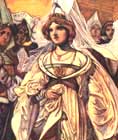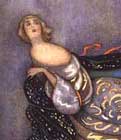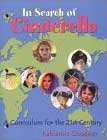
Cinderella:
345 Variants
by Marian
Roalfe Cox
SurLaLune's
Cinderella Area
SurLaLune Fairy Tales Main Page
305
Wlislocki, Heinrich von, Märchen und Sagen der Bukowinaer und Siebenburger Armenier. Aus eigenen und fremden Sammlungen ubersetzt. Hamburg, 1892. Pp. 55-58. No. XXII.
"KONIG AMBANOR UND DAS WAISENMADCHEN."1
ABSTRACT
King, being urged to marry against his will, at length promises to take as his queen any girl who, at distance of hundred paces, can knock crown off his head with an apple--Marriage test-- Heroine appears veiled and flower-bedecked; knocks off crown with diamond apple, then vanishes. This happens thrice. Third time king picks up diamond apple, and sees heroine's face in it. Heroine quest--Love-sick king--King, benighted in mountains, seeks shelter in old woman's hut. During night overhears soft voice amid old woman's scoldings inquires next morning; hears of good-for-nothing step-daughter, who wastes bread on pet owl that gave her three diamond apples. Recognition of heroine-- Happy marriage.
TABULATION
(1) Many thousand years ago lived handsome young king, whose might and happiness surpassed that of the Babylonian King Pharaoh himself. His ministers often urged him to marry, but he always replied that he wished to serve his country and his God, and had no time for a wife. At length they insist on his marrying, if he would remain king over them.-- (2) But King Ambanor, having no intention of marrying, bethinks him of an artifice, and declares his willingness to carry out their wish. But he will only have to wife a girl who, at a distance of one hundred paces, can knock the crown off his head with an apple; for only such a one would be worthy and competent to share the throne. On New Year's Day all marriageable girls in the land are to assemble in the large meadow before the royal residence, and make the cast at the crown. So it happens; but not one of the girls succeeds. Most of them throw the apple over king's head, being afraid of hitting his face, and losing their lives according to law.-- (3) When all have tried, King Ambanor asks, cheerfully, if there is any girl left who has not yet thrown. "Yes," says a voice, and from behind a bush steps forth a thickly-veiled tall girl, entirely covered in exquisite flowers, so that no part of her clothes is seen. She steps up to the mark, takes out a diamond apple, and throws. King Ambanor a crown falls to the ground. The people cheer; but when they would lead her to the king, the girl has disappeared, no one knows whither.-- (4) King is vexed, for he was curious to see the face of the veiled maiden. He orders search to be made for her in every direction. No one, however, can find her. He is still more annoyed, and one day has all girls again assembled in meadow to throw at his crown. But again no one hits it. At length the veiled and flower-decked maiden appears. Once more she throws a diamond apple, and, as the crown falls to the ground, vanishes. She is sought in vain throughout the land.-- (5) A third time king assembles all marriageable girls to throw at his crown. All happens as before. But when king, full of vexation, picks up the diamond apple, the face of a most lovely girl looks forth at him as from a mirror, he is well pleased, and exclaims that she and none other shall be his bride. All are to come and gaze at her picture. None know who she is.-- (6) King is inconsolable, shuts himself up, and will speak to none; or he ranges the forests, hunting. On one occasion night overtakes him on a mountain. He sees a hut in which he thinks to pass the night. He enters, and sees a hideous old woman sitting at the hearth with her two hideous daughters. He asks for night's lodging, the which old woman only grants on learning that he is King Ambanor. He is weary, and stretches himself on the straw bed, but cannot sleep; for all night long the old woman is holloaing and raging outside in the kitchen like mad. Now and then he hears a soft-toned voice in the midst of the scoldings.-- (7) Next morning, before leaving, he rewards old woman and her daughters, and then asks Who it was she was scolding last night. Old woman complains that she has a good-for-nothing stepdaughter in the house, who imagines herself to be more beautiful than her own daughters, and now is quite off her head, and feeds an owl with old woman's scanty bread, declaring that it gave her three diamond apples. King is full of curiosity, and says, "Your daughters are indeed lovely. I'd give something to see the girl who imagines herself lovelier. Let's see her." Old woman shouts into kitchen, "Come here, you dirty baggage!" And, clad in rags, a lovely girl steps in. King cries out that he has been seeking her, embraces her, and says she shall be his wife, leads her home, and lives happily with her, and reigns to his life's end.
1: This märchen is, in the words
of Hanusch, "one of the most important reminiscences of Armenian
mythology", for in King Ambanor is hidden the name of the ancient
Armenian Spring-goddess, Amanora, to whom also points the flower-decked
maiden. The festival of this Spring-goddess was celebrated at the New
Year, when the fruits grown in the year were offered to her. A faint reminiscence
of the festival is figured in the custom of the Transylvanian Armenians
of preparing on New Year's Day a dish called dalausi, composed of nuts,
poppy, raisins, and lemons, which is consecrated by the priest, and shared
as a New Year's gift among friends and acquaintance.
Return to place in text.
Cox, Marian Roalfe. Cinderella: Three Hundred and Forty-five Variants of Cinderella, Catskin, and Cap O' Rushes, abstracted and tabulated. London: David Nutt for the Folklore Society, 1893.
While the original text of this book is out of copyright, the special formatting and compilation available on SurLaLune Fairy Tales is copyrighted. Be aware that while the original content has been honored, page numbering, footnote numbering, redesigned charts, links, and other aspects are unique to this site's version of the text. Use at your own risk. For private and fair use educational purposes only.
©Heidi
Anne Heiner, SurLaLune Fairy Tales
E-mail: surlalune@aol.com
Page last updated February 1, 2006
www.surlalunefairytales.com










